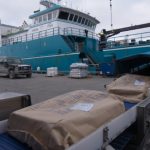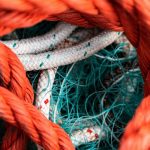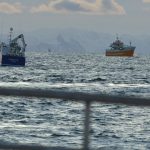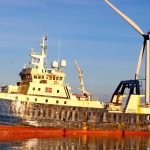NOAA recently took delivery of Pisces, the third of four new fisheries survey vessels and a significant achievement in the agency’s efforts to modernize its fleet of fisheries, oceanographic, and hydrographic survey ships.
The ship, which will carry a crew of 21 and up to 17 scientists, will support NOAA’s mission to protect, restore, and manage the use of living marine, coastal, and ocean resources. Her primary objective will be to study, monitor, and collect data on a wide range of sea life and ocean conditions, primarily in U.S. waters from the Gulf of Mexico, Caribbean, and South Atlantic to North Carolina. This region includes important commercial and recreational fisheries, and is one of the world’s best known and most productive marine areas.
Pisces is the third in a series of four planned 208-foot fisheries survey ships replacing aging ships in the NOAA fleet. It was launched in December 2007 and delivered to NOAA today by VT Halter Marine Inc. It will be commissioned and placed into operation in October 2009, after several more months of outfitting and shakedown with its homeport in Pascagoula, Miss.
“The Pisces represents a new generation of advanced fisheries survey vessels,” said Rear Adm. Jonathan Bailey, director of NOAA’s Office of Marine and Aviation Operations. “This ship is vibration and noise-dampened and is an extremely quiet vessel under way. The Pisces is equipped with state-of-the art technology in order to carry out a wide variety of research work for the nation for years to come.”
The data collected by the ship will be used by scientists who study variation in ocean conditions and sea life and how they relate to such issues as sustainable fisheries, fish habitat, habitat restoration, coral reefs, and protected species status. Pisces also will observe weather, conduct habitat assessments, and survey marine mammal and bird populations.
Foremost among Pisces’s state-of-the-art capabilities is the ship’s “quiet” hull, which minimizes underwater sounds made by the ship. This allows scientists to use hydroacoustic methods for surveying marine life, and significantly reduces changes in the natural behavior of animals caused by ship noise.
“With its dramatically lower background noise levels, this ship will greatly enhance our ability to use the most sophisticated acoustic devices to assess fish, marine mammal and sea turtle stocks,” said James Balsiger, acting NOAA assistant administrator for NOAA’s Fisheries Service. “Pisces will not only expand the type of information we are able to obtain, but as a multipurpose vessel will improve our ability to support ecosystem approaches to management of the oceans.”
The ship was named by a team of five seventh grade students from Sacred Heart School in Southaven, Miss. The team won a regional NOAA contest to name the ship by submitting a winning essay that supported their name selection. The contest was an educational initiative to help students learn more about their region’s marine and coastal environment as well as to generate a greater interest in scientific studies.
NOAA understands and predicts changes in the Earth’s environment, from the depths of the ocean to the surface of the sun, and conserves and manages our coastal and marine resources.








